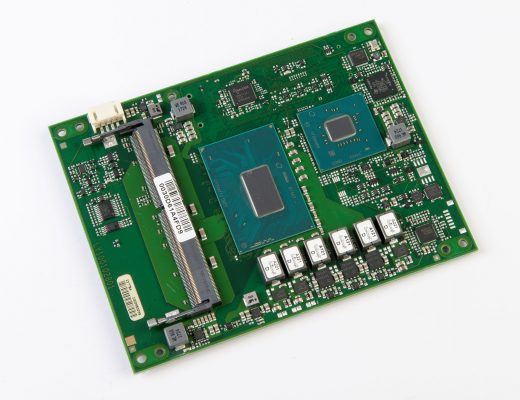88% More Performance per Watt for Embedded and IoT
In an increasingly visual, connected world, video and wireless capabilities are no longer a luxury—they are often a requirement. This places unique demands on embedded systems that must balance power consumption, heat dissipation, and price with the high resource and performance demands of video and communications.
These demands are being met by 8th generation Intel® Core™ processors (formerly Coffee Lake), which in tandem with a new set of companion chipsets, provide 88 percent better performance per watt (PPW) along with the foundations for wireless connectivity.
Additional features such as an increase in the maximum number of cores from four to six, higher turbo speeds, and faster memory support now empower embedded systems developers to deliver the interactive experiences users have come to expect.
More Cores, More Codecs, and a Thermal Velocity Boost
The 8th generation Intel Core processor family currently consists of mobile and desktop variants, many of which have been designed for embedded use. The chips are built on 14-nm process technology to maximize performance while reducing leakage power compared to larger process nodes. The advanced process technology also sets the stage for other major architectural enhancements, such as the availability of up to six cores on select SKUs that maintain TDP levels in the 35-W to 45-W range (Figure 1).
The new generation of Intel Core processors features Intel® Hyper-Threading Technology (Intel® HT Technology), allowing two threads to run simultaneously on each physical processor core. Workloads can therefore be completed more quickly because application tasks can be executed in parallel, resulting in more efficient processor utilization, lower total power consumption, and better thermal management.
Another way these processors maximize available resources is through a new technology called Intel® Thermal Velocity Boost (Intel® TVB). Intel TVB works with Intel® Turbo Boost Technology (Intel® TBT) to opportunistically deliver up to 200 MHz of additional clock speed when the processor is operating below specified thermal and power limits (Figure 2).
The six-core Intel® Core™ i7-8850H mobile processor, for instance, has a base frequency of 2.6 GHz but can achieve speeds as high as 4.3 GHz thanks to Intel TBT and Intel TVB. This additional boost can be critical for providing a seamless user experience in applications with bursty workloads, such as video streaming.
From a graphics perspective, 8th generation Intel Core processors are equipped with the Intel® UHD Graphics 630. Add this to the other architectural enhancements of the new processors, and the gain is a 20 percent improvement in the 3DMark benchmark.
These gains are aided by Intel® Quick Sync Video, offering built-in hardware support for video codecs such as 10-bit HEVC encode and decode and 10-bit VP9 decode. The processors additionally support High Dynamic Range (HDR) and Rec. 2020 color space media across as many as three independent displays for 4K ultra-high-definition (UHD) video streaming.
Platforms based on the 8th generation Intel Core processor incorporate several memory upgrades to sustain the uptick in processing performance, including support for up to 64 Gbytes of 2666 MHz DDR4 RAM, an integrated memory controller, and Intel® Smart Cache technology. The integrated memory controller stores efficient pre-fetching algorithms that result in higher memory bandwidth, while Intel Smart Cache helps reduce latencies by dynamically allocating available cache to cores based on their workload (Figure 3).
More, Faster I/O and Connected Companions
To bring these capabilities out in embedded systems, 8th generation Core® processors add four I/O ports to what was available in previous-generation processors. This results in up to 30 high-speed I/O interfaces from a single part, with support for as many as six USB 3.1 Gen 2 lanes using flex I/O and up to 16 PCIe 3.0 lanes. When combined with the 24 PCIe lanes available on companion chipsets, systems with high bandwidth requirements can now take advantage of 40 PCIe interfaces.
It's important to note that the new Cannon Point (CNP) chipsets that accompany 8th generation Intel Core processors remove the Intel® Low Pin Count (LPC) interface, which defined seven to 13 signal lines. This is replaced by Intel's enhanced SPI (eSPI) with four signal lines. The reduced number of signal lines minimizes the number of PCB traces required for communications. eSPI also runs at 66 MHz, twice the frequency of LPC, and saves power by operating at 1.8 V compared to LPC's 3.3 V.
But perhaps the most significant feature of the new generation of platform controller hubs (PCHs) is integrated Intel® Wireless-AC 2×2 160 MHz. Intel Wireless-AC 2×2 160 MHz defines the media access control (MAC) layer for Wi-Fi communications at rates of up to 1,733 Mbit/s (the PHY layer must be implemented separately). As shown in Figure 4, this enables HD file downloads in a fraction of the time of preceding technologies.
For embedded developers looking to take advantage of this connectivity alongside the compute performance of 8th generation Intel Core processors, Intel has qualified parts for use in the broad embedded market. These devices, such as the six-core Intel Core i7-8850H, quad-core Intel Core i5-8400H, and Intel Q370® chipset, are backed by 15-year product availability and are available on modules like the C6B-CFLH COM Express Type 6 board from MSC Technologies GmbH (Figure 5).

Redefining the Embedded Experience
As users of all types grow more accustomed to the benefits of HD video and wireless connectivity, embedded systems too will be forced to adapt. But doing so means selecting a processor architecture and supporting hardware that both complies with traditional design constraints and also supports advanced new features.
8th generation Intel Core processors exist at the intersection of these requirements, providing the performance necessary for next-generation graphics and wireless connectivity in embedded-friendly TDP envelopes. Additional announcements around the scalable family of processors are expected in the coming months that address security, management, and other capabilities to help today's engineers further redefine the embedded experience.